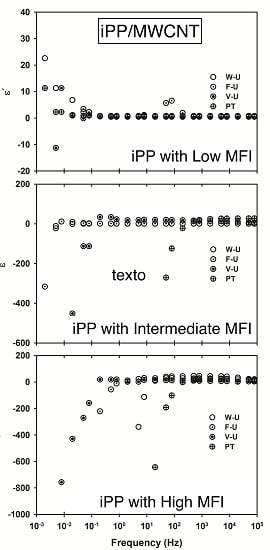Metamaterial Behavior of Polymer Nanocomposites Based on Polypropylene/Multi-Walled Carbon Nanotubes Fabricated by Means of Ultrasound-Assisted Extrusion
Abstract
:1. Introduction

2. Results
2.1. Electrical Properties of iPP
2.2. Elecrical Properties of iPP/MWCNT Polymer Nanocomposites
2.2.1. Dielectric Constant, ε′
2.2.2. Electrical Conductivity, σ(AC)
2.2.3. Voltage Effect on ε′ and σ(AC)
3. Discussion
4. Materials and Methods
5. Conclusions
Supplementary Materials
Acknowledgments
Author Contributions
Conflicts of Interest
References
- Chung, T.C.M. Functionalization of polypropylene with high dielectric properties: Applications in electric energy storage. Green Sustain. Chem. 2012, 2, 29–37. [Google Scholar] [CrossRef]
- Alig, I.; Lellinger, D.; Dudkin, S.M.; Pötschke, P. Conductivity spectroscopy on melt processed polypropylene-multiwalled carbon nanotube composites: Recovery after shear and crystallization. Polymer 2007, 48, 1020–1029. [Google Scholar] [CrossRef]
- Logakis, E.; Pollatos, E.; Pandis, C.; Peoglos, V.; Zuburtikudis, I.; Delides, C.G.; Vatalis, A.; Gjoka, M.; Syskakis, E.; Viras, K.; et al. Structure-property relationships in isotactic polypropylene/multi-walled carbon nanotubes nanocomposites. Compos. Sci. Technol. 2010, 70, 328–335. [Google Scholar] [CrossRef]
- Prashantha, K.; Soulestin, J.; Lacrampe, M.F.; Krawczak, P.; Dupin, G.; Claes, M.; Tewari, A. Electrical and dielectric properties of multi-walled carbon nanotube filled polypropylene nanocomposites. Polym. Polym. Compos. 2010, 18, 489–494. [Google Scholar]
- Haque, M.A.; Mina, M.F.; Alam, A.; Rahman, M.J.; Bhuiyan, M.A.; Asano, T. Multiwalled carbon nanotubes-reinforced isotactic polypropylene nanocomposites: Enhancement of crystallization and mechanical, thermal, and electrical properties. Polym. Compos. 2012, 33, 1094–1104. [Google Scholar] [CrossRef]
- Bhagat, N.A.; Shrivastava, N.K.; Suin, S.; Maiti, S.; Khatua, B.B. Development of electrical conductivity in pp/hdpe/mwcnt nanocomposite by melt mixing at very low loading of mwcnt. Polym. Compos. 2013, 34, 787–798. [Google Scholar] [CrossRef]
- Wang, D.; Zhang, X.; Zha, J.-W.; Zhao, J.; Dang, Z.-M.; Hu, G.-H. Dielectric properties of reduced graphene oxide/polypropylene composites with ultralow percolation threshold. Polymer 2013, 54, 1916–1922. [Google Scholar] [CrossRef]
- Li, B.; Sui, G.; Zhong, W.-H. Single negative metamaterials in unstructured polymer nanocomposites toward selectable and controllable negative permittivity. Adv. Mater. 2009, 21, 4176–4180. [Google Scholar] [CrossRef]
- Veselago, V. Properties of materials having simultaneously negative values of the dielectric and the magnetic susceptibilities. Sov. Phys. Solid State 1967, 8, 2854–2856. [Google Scholar]
- Veselago, V.G. The electrodynamics of substances with simultaneously negative values of ε and μ. Sov. Phys. Uspekhi 1968, 10, 509–514. [Google Scholar] [CrossRef]
- Pendry, J.B.; Holden, A.J.; Stewart, W.J.; Youngs, I. Extremely low frequency plasmons in metallic mesostructures. Phys. Rev. Lett. 1996, 76, 4773–4776. [Google Scholar] [CrossRef] [PubMed]
- Pendry, J.B.; Holden, A.J.; Robbins, D.J.; Stewart, W.J. Low frequency plasmons in thin-wire structures. J. Phys. Condens. Matter 1998, 10, 4785–4809. [Google Scholar] [CrossRef]
- Hilt, O.; Brom, H.B.; Ahlskog, M. Localized and delocalized charge transport in single-wall carbon-nanotube mats. Phys. Rev. B 2000, 61, R5129–R5132. [Google Scholar] [CrossRef]
- Zhu, J.; Wei, S.; Zhang, L.; Mao, Y.; Ryu, J.; Mavinakuli, P.; Karki, A.B.; Young, D.P.; Guo, Z. Conductive polypyrrole/tungsten oxide metacomposites with negative permittivity. J. Phys. Chem. C 2010, 114, 16335–16342. [Google Scholar] [CrossRef]
- Zhu, J.; Wei, S.; Ryu, J.; Guo, Z. Strain-sensing elastomer/carbon nanofiber “metacomposites”. J. Phys. Chem. C 2011, 115, 13215–13222. [Google Scholar] [CrossRef]
- Zhu, J.; Wei, S.; Zhang, L.; Mao, Y.; Ryu, J.; Karki, A.B.; Young, D.P.; Guo, Z. Polyaniline-tungsten oxide metacomposites with tunable electronic properties. J. Mater. Chem. 2011, 21, 342–348. [Google Scholar] [CrossRef]
- Zhu, J.; Gu, H.; Luo, Z.; Haldolaarachige, N.; Young, D.P.; Wei, S.; Guo, Z. Carbon nanostructure-derived polyaniline metacomposites: Electrical, dielectric, and giant magnetoresistive properties. Langmuir 2012, 28, 10246–10255. [Google Scholar] [CrossRef] [PubMed]
- Zhu, J.; Zhang, X.; Haldolaarachchige, N.; Wang, Q.; Luo, Z.; Ryu, J.; Young, D.P.; Wei, S.; Guo, Z. Polypyrrole metacomposites with different carbon nanostructures. J. Mater. Chem. 2012, 22, 4996–5005. [Google Scholar] [CrossRef]
- Zhang, X.; Yan, X.; He, Q.; Wei, H.; Long, J.; Guo, J.; Gu, H.; Yu, J.; Liu, J.; Ding, D.; et al. Electrically conductive polypropylene nanocomposites with negative permittivity at low carbon nanotube loading levels. ACS Appl. Mater. Interfaces 2015, 7, 6125–6138. [Google Scholar] [CrossRef] [PubMed]
- Ramasamy, R.P.; Yang, K.; Rafailovich, M.H. Polypropylene-graphene—A nanocomposite that can be converted into a meta-material at desired frequencies. RSC Adv. 2014, 4, 44888–44895. [Google Scholar] [CrossRef]
- Zhong, J.; Isayev, A.I.; Huang, K. Influence of ultrasonic treatment in pp/cnt composites using masterbatch dilution method. Polymer 2014, 55, 1745–1755. [Google Scholar] [CrossRef]
- Ávila-Orta, C.A.; Jurado-Quiñones, Z.V.; Waldo-Mendoza, M.A.; Rivera-Paz, E.A.; Cruz-Delgado, V.C.J.; Mata-Padilla, J.M.; González-Morones, P.; Ziolo, R.F. Ultrasound-assist extrusion methods for the fabrication of polymer nanocomposites based on polypropylene/multi-wall carbon nanotubes. Materials 2015, 8, 7900–7912. [Google Scholar] [CrossRef]
- Kohlman, R.S.; Joo, J.; Wang, Y.Z.; Pouget, J.P.; Kaneko, H.; Ishiguro, T.; Epstein, A.J. Drude metallic response of polypyrrole. Phys. Rev. Lett. 1995, 74, 773–776. [Google Scholar] [CrossRef] [PubMed]
- Hom, S.; Bhattacharyya, A.R.; Khare, R.A.; Kulkarni, A.R.; Saroop, M.; Biswas, A. Blends of polypropylene and ethylene octene comonomer with conducting fillers: Influence of state of dispersion of conducting fillers on electrical conductivity. Polym. Eng. Sci. 2009, 49, 1502–1510. [Google Scholar] [CrossRef]
- Tambe, P.B.; Bhattacharyya, A.R.; Kulkarni, A.R. The influence of melt-mixing process conditions on electrical conductivity of polypropylene/multiwall carbon nanotubes composites. J. Appl. Polym. Sci. 2013, 127, 1017–1026. [Google Scholar] [CrossRef]
- Avila-Orta, C.A.; Raudry-Lopez, C.E.; Davila-Rodriguez, M.V.; Aguirre-Figueroa, Y.A.; Cruz-Delgado, V.J.; Neira-Velazquez, M.G.; Medellin-Rodriguez, F.J.; Hsiao, B.S. Morphology, thermal stability, and electrical conductivity of polymer nanocomposites of isotactic polypropylene/multi-walled carbon nanotubes. Int. J. Polym. Mater. Polym. Biomater. 2013, 62, 635–641. [Google Scholar] [CrossRef]
- Espinoza-Martinez, A.; Avila-Orta, C.; Cruz-Delgado, V.; Olvera-Neria, O.; Gonzalez-Torres, J.; Medellin-Rodriguez, F. Nucleation mechanisms of aromatic polyesters, pet, pbt, and pen, on single-wall carbon nanotubes: Early nucleation stages. J. Nanomater. 2012, 2012, 189820. [Google Scholar] [CrossRef]
- Smith, D.R.; Padilla, W.J.; Vier, D.C.; Nemat-Nasser, S.C.; Schultz, S. Composite medium with simultaneously negative permeability and permittivity. Phys. Rev. Lett. 2000, 84, 4184–4187. [Google Scholar] [CrossRef] [PubMed]
- Gordon, K.L.; Kang, J.H.; Park, C.; Lillehei, P.T.; Harrison, J.S. A novel negative dielectric constant material based on phosphoric acid doped poly(benzimidazole). J. Appl. Polym. Sci. 2012, 125, 2977–2985. [Google Scholar] [CrossRef]
- Gordon, K.L.; Kang, J.H.; Park, C.; Lillehei, P.T.; Harrison, J.S. Negative Dielectric Constant Material Based on Ion Conducting Materials. U.S. Patent 8,696,940, 15 April 2014. [Google Scholar]
- Ávila-Orta, C.A.; Martínez-Colunga, J.G.; Bueno-Baqués, D.; Raudry-López, C.E.; Cruz-Delgado, V.J.; González-Morones, P.; Valdéz-Garza, J.A.; Esparza-Juárez, M.E.; Espinoza-González, C.J.; Rodríguez-González, J.A. Continuous Method Assisted by Ultrasound with a Variable Amplitude and Frequency for the Preparation of Nanocompounds Based on Polymers and Nanoparticles. MX Patent 323756 B, 19 September 2014. [Google Scholar]
- España-Sánchez, B.L.; Ávila-Orta, C.A.; Padilla-Vaca, F.; Neira-Velázquez, M.G.; González-Morones, P.; Rodríguez-González, J.A.; Hernández-Hernández, E.; Rangel-Serrano, A.; Barriga, E.D.; Yate, L.; et al. Enhanced antibacterial activity of melt processed poly(propylene) Ag and Cu nanocomposites by argon plasma treatment. Plasma Process. Polym. 2014, 11, 353–365. [Google Scholar] [CrossRef]
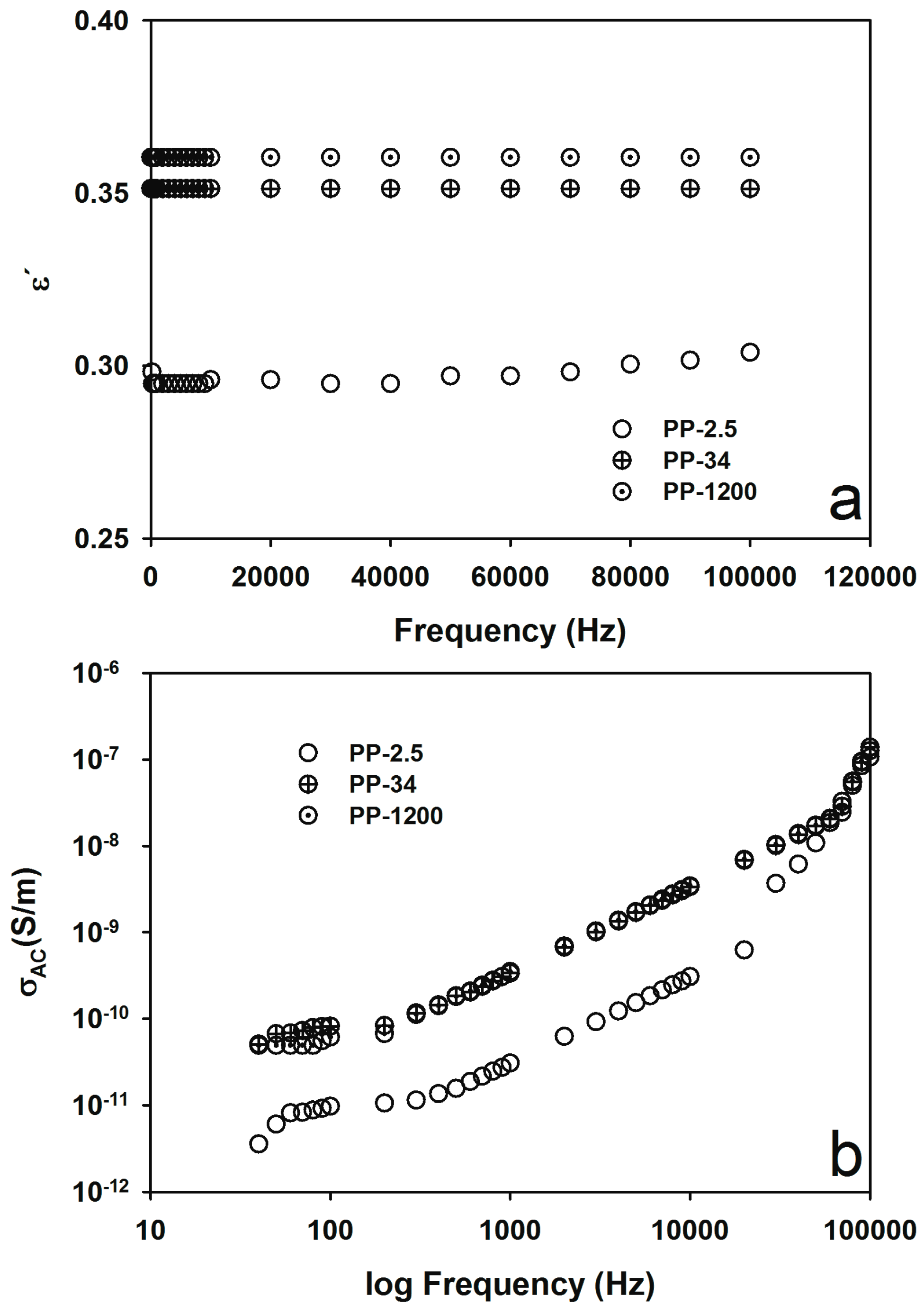
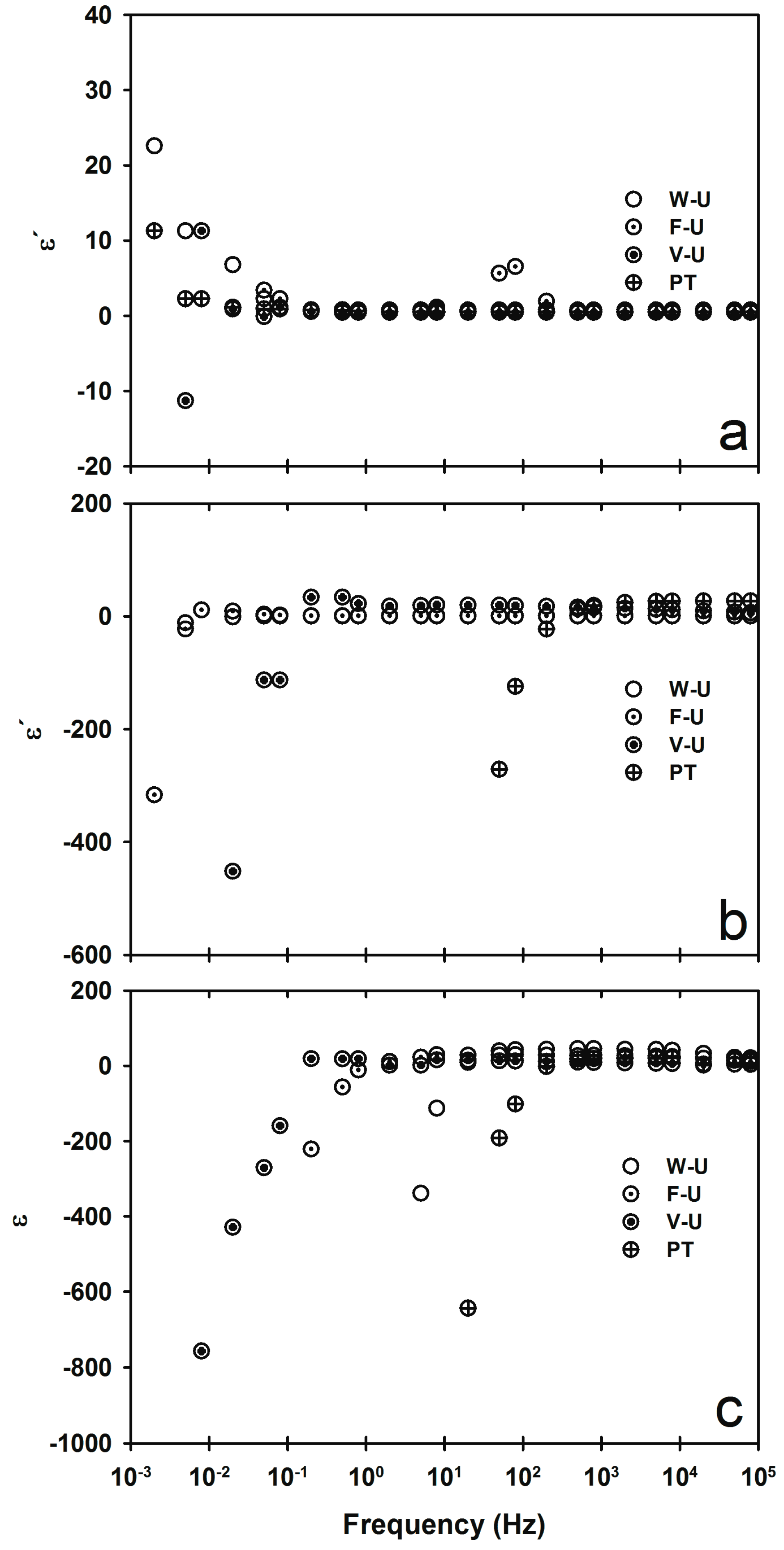


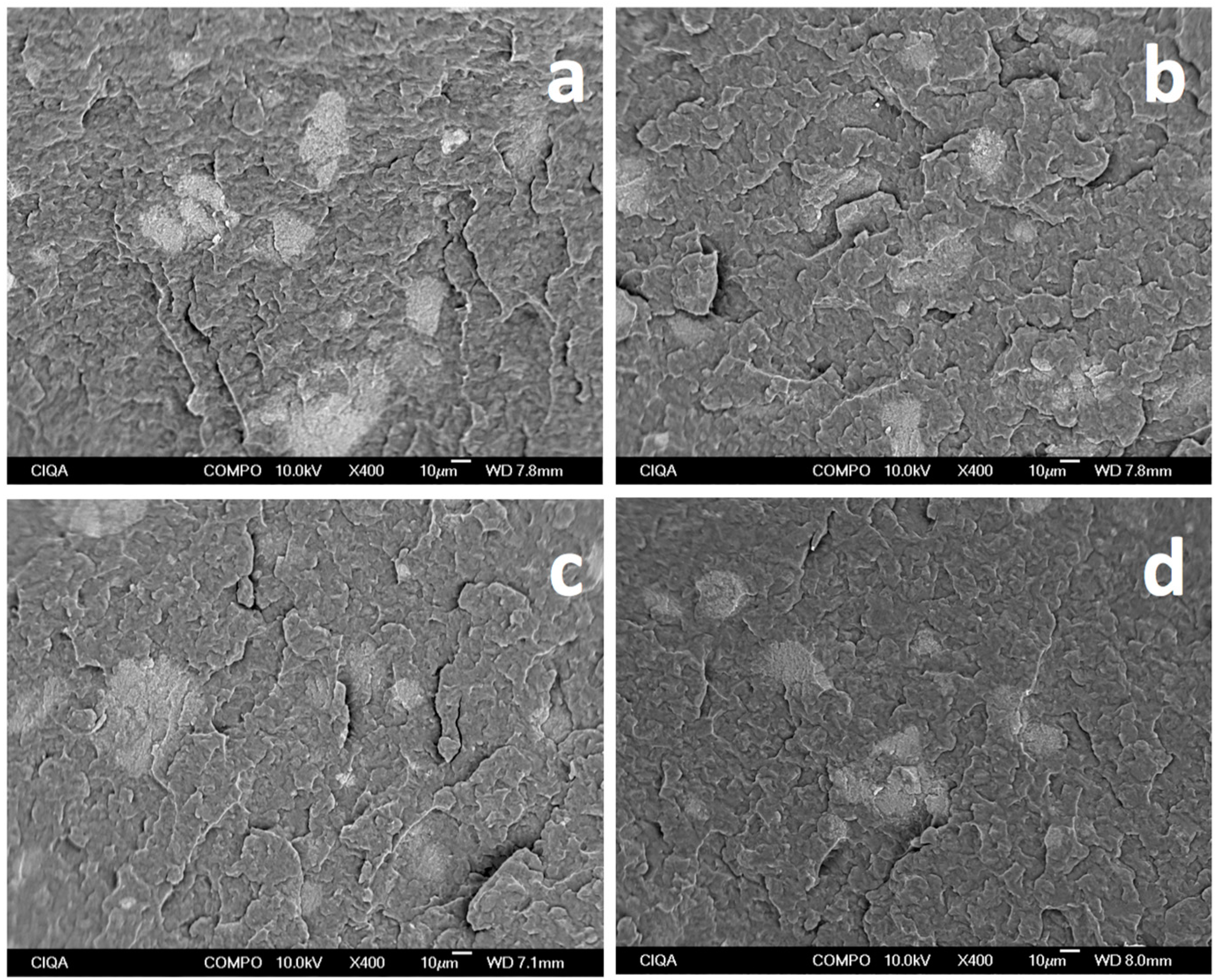

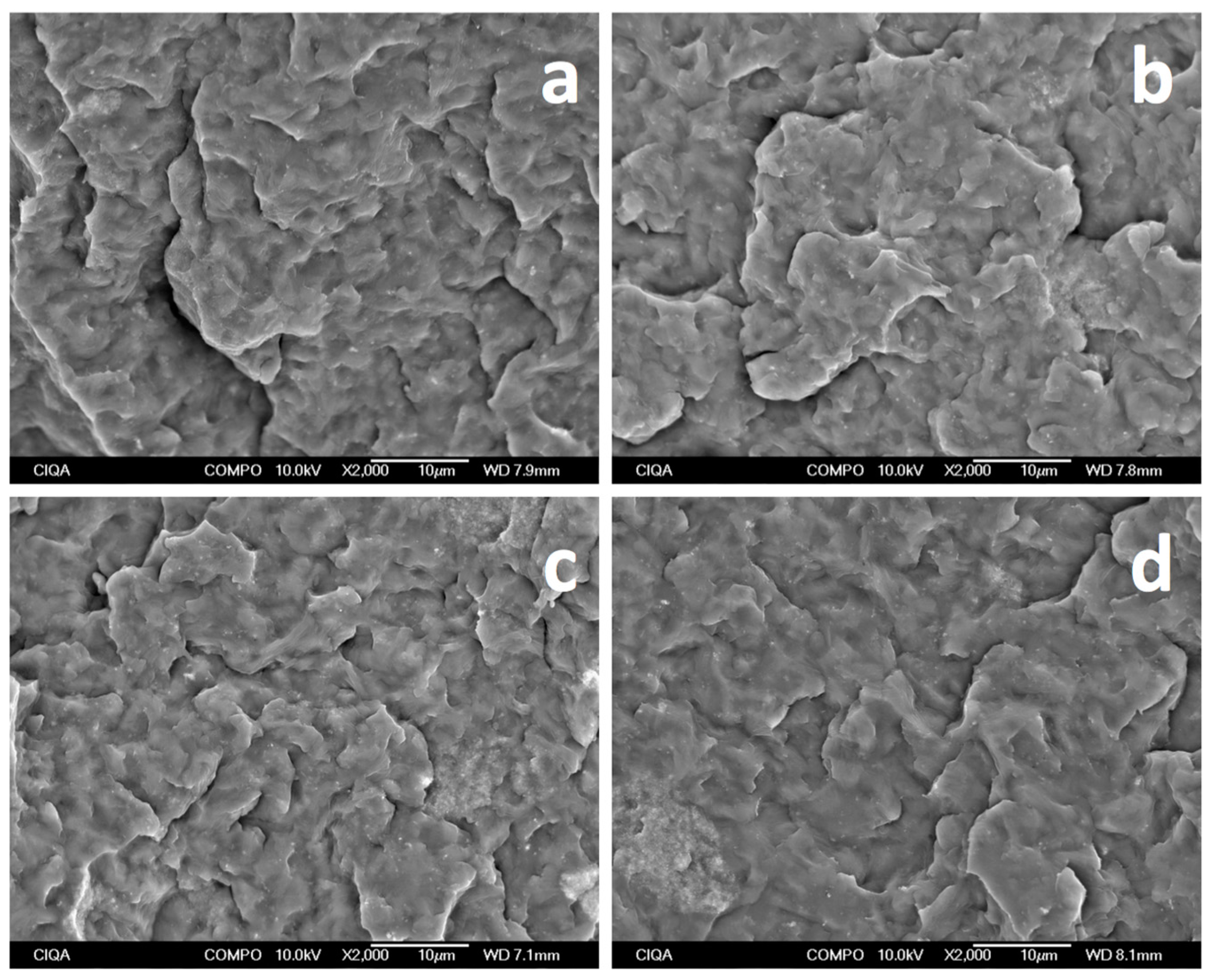
| Sample | Fabrication Method | |||
|---|---|---|---|---|
| W-U | F-U | V-U | PT | |
| iPPMFI=2.5/MWCNT | Insulator | Insulator | Insulator | Insulator |
| N/A | N/A | N/A | N/A | |
| N/A | N/A | N/A | N/A | |
| N/A | N/A | N/A | N/A | |
| iPPMFI=34/MWCNT | Insulator | Static-dissipative | Static-dissipative | Conductor |
| N/A | 0.006 Hz | 0.1 Hz | 400 Hz | |
| N/A | −102 | −103 | −107 | |
| N/A | Metamaterial | Metamaterial | Metamaterial | |
| iPPMFI=1200/MWCNT | Conductor | Static-dissipative | Static-dissipative | Conductor |
| 20 Hz | 0.9 Hz | 0.1 Hz | 300 Hz | |
| −106 | −105 | −103 | −107 | |
| Metamaterial | Metamaterial | Metamaterial | Metamaterial | |
© 2016 by the authors; licensee MDPI, Basel, Switzerland. This article is an open access article distributed under the terms and conditions of the Creative Commons Attribution (CC-BY) license (http://creativecommons.org/licenses/by/4.0/).
Share and Cite
Pérez-Medina, J.C.; Waldo-Mendoza, M.A.; Cruz-Delgado, V.J.; Quiñones-Jurado, Z.V.; González-Morones, P.; Ziolo, R.F.; Martínez-Colunga, J.G.; Soriano-Corral, F.; Avila-Orta, C.A. Metamaterial Behavior of Polymer Nanocomposites Based on Polypropylene/Multi-Walled Carbon Nanotubes Fabricated by Means of Ultrasound-Assisted Extrusion. Materials 2016, 9, 923. https://doi.org/10.3390/ma9110923
Pérez-Medina JC, Waldo-Mendoza MA, Cruz-Delgado VJ, Quiñones-Jurado ZV, González-Morones P, Ziolo RF, Martínez-Colunga JG, Soriano-Corral F, Avila-Orta CA. Metamaterial Behavior of Polymer Nanocomposites Based on Polypropylene/Multi-Walled Carbon Nanotubes Fabricated by Means of Ultrasound-Assisted Extrusion. Materials. 2016; 9(11):923. https://doi.org/10.3390/ma9110923
Chicago/Turabian StylePérez-Medina, Juan C., Miguel A. Waldo-Mendoza, Víctor J. Cruz-Delgado, Zoe V. Quiñones-Jurado, Pablo González-Morones, Ronald F. Ziolo, Juan G. Martínez-Colunga, Florentino Soriano-Corral, and Carlos A. Avila-Orta. 2016. "Metamaterial Behavior of Polymer Nanocomposites Based on Polypropylene/Multi-Walled Carbon Nanotubes Fabricated by Means of Ultrasound-Assisted Extrusion" Materials 9, no. 11: 923. https://doi.org/10.3390/ma9110923





